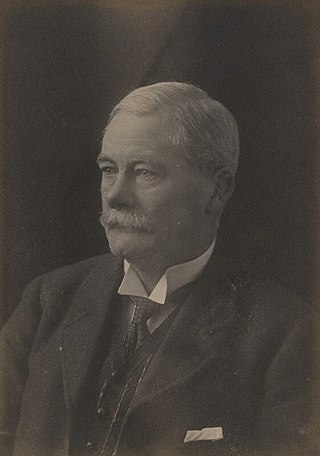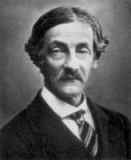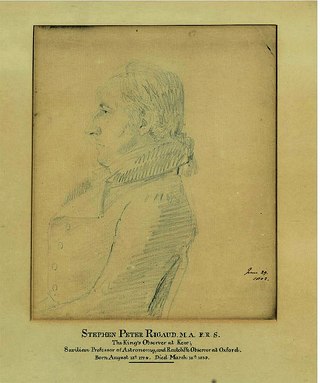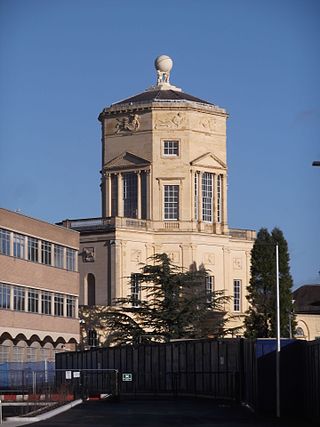
Nathaniel Bliss was an English astronomer of the 18th century, serving as Britain's fourth Astronomer Royal between 1762 and 1764.

Herbert Hall Turner was a British astronomer and seismologist.
Manuel John Johnson, FRS was a British astronomer.

Alexander Stewart Herschel, DCL, FRS was a British astronomer.
Alan William James Cousins FRAS was a South African astronomer. His career spanned 70 years during which time he concentrated on the measurement of variable stars, including the measurement of the two sinusoidal periods of Gamma Doradus. The UBV photometric system for measuring stellar fluxes he devised in his 1990s became a standard known as the "Cousins system".

South African Astronomical Observatory (SAAO) is the national centre for optical and infrared astronomy in South Africa. It was established in 1972. The observatory is run by the National Research Foundation of South Africa. The facility's function is to conduct research in astronomy and astrophysics. The primary telescopes are located in Sutherland, which is 370 kilometres (230 mi) from Observatory, Cape Town, where the headquarters is located.

North Oxford is a suburban part of the city of Oxford in England. It was owned for many centuries largely by St John's College, Oxford and many of the area's Victorian houses were initially sold on leasehold by the College.

The position of Savilian Professor of Astronomy was established at the University of Oxford in 1619. It was founded by Sir Henry Savile, a mathematician and classical scholar who was Warden of Merton College, Oxford, and Provost of Eton College. He appointed John Bainbridge as the first professor, who took up his duties in 1620 or 1621.
Thomas Hornsby was a British astronomer and mathematician.

Stephen Peter Rigaud FRAS was an English mathematical historian and astronomer. Rigaud was born into a French Protestant family. His father, Stephen Rigaud, was Observer at the Kew Observatory. The painter John Francis Rigaud, who painted a portrait of Rigaud, aged four, and his sister Mary Anne was not his uncle but other possible connections are unknown.

Walton Street is on the eastern edge of the Jericho district of central Oxford, England.

The Oxford University Science Area in Oxford, England, is where most of the science departments at the University of Oxford are located.
John Plowman (c.1773–1843) was an English architect based in Oxford. His younger son John Plowman (1807–1871) also worked on buildings on Oxford, leading to issues with attribution.
Walton Manor is a residential suburb in Oxford, England. It is north of Jericho and the Radcliffe Observatory Quarter and forms part of North Oxford. The street layout and many of the area's buildings date from the mid-19th century. It was developed on land belonging to St John's College, Oxford.

Green Templeton College (GTC) is a constituent college of the University of Oxford in the United Kingdom. The college is located on the former Green College site on Woodstock Road next to the Radcliffe Observatory Quarter in North Oxford and is centred on the architecturally important Radcliffe Observatory, an 18th-century building, modelled on the ancient Tower of the Winds at Athens. It is the university's second newest graduate college, after Reuben College, having been founded by the historic merger of Green College and Templeton College in 2008.
David Stanley Evans was a British astronomer, noted for his use of lunar occultations to measure stellar angular diameters during the 1950s.

Observatory Street is a street in Oxford, England. It links at the eastern end Woodstock Road in central North Oxford and at the western end Walton Street and the Jericho area of Oxford, England.

The position of Savilian Professor of Geometry was established at the University of Oxford in 1619. It was founded by Sir Henry Savile, a mathematician and classical scholar who was Warden of Merton College, Oxford, and Provost of Eton College, reacting to what has been described by one 20th-century mathematician as "the wretched state of mathematical studies in England" at that time. He appointed Henry Briggs as the first professor. Edward Titchmarsh said when applying that he was not prepared to lecture on geometry, and the requirement was removed from the duties of the post to enable his appointment, although the title of the chair was not changed. The two Savilian chairs have been linked with professorial fellowships at New College, Oxford, since the late 19th century. Before then, for over 175 years until the middle of the 19th century, the geometry professors had an official residence adjoining the college in New College Lane.

The Tower of the Winds is the prominent octagonal tower on top of the old Radcliffe Observatory building in Oxford, England. The building now forms a centrepiece for Green Templeton College, one of the colleges of Oxford University.
Joseph Gurney Barclay FRAS was the son of Robert and Elizabeth Barclay. Joseph Gurney Barclay followed the banking profession for more than fifty years. In his later career he was head of the Barclay & Bevan bank and retired at the age of 80 when his bank amalgamated with others into a limited company in 1896, becoming Barclays. He was also a life member of the Meteorological Society.
















